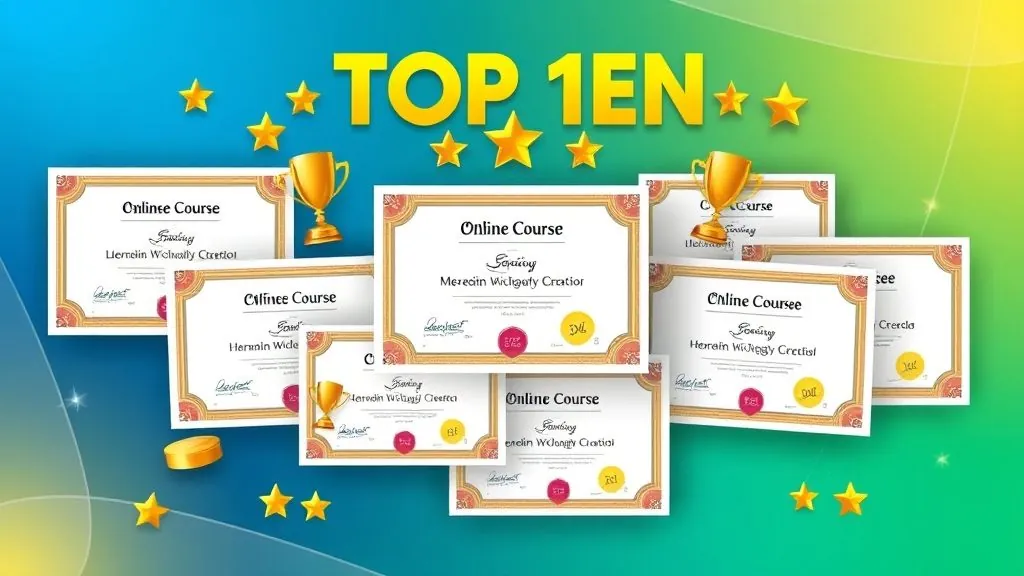Are you fascinated by artificial intelligence, data-driven technology, and the rapidly evolving landscape of smart applications shaping our world today? The journey begins here—the best machine learning courses for beginners are your launchpad into one of the most sought-after skillsets of this decade. As machine learning transforms how we interact with technology, industries worldwide are investing in talent who can build clever algorithms and understand the data shaping tomorrow’s breakthroughs.
Learning machine learning isn’t just about boosting your career prospects. It’s about developing critical thinking, understanding how modern tools make predictions and automate choices, and gaining the confidence to solve personal, academic, or business challenges with code. Whether you’re a student in Lagos, an entrepreneur in Brazil, a professional pivoting in Europe, or simply a curious mind, beginner-friendly courses are now more accessible than ever—empowering learners across continents to unlock opportunities in data science, AI, and beyond.
In this comprehensive guide, you’ll explore not only hand-picked machine learning courses designed for novices but also the practical advice, real-world project ideas, and community engagement strategies that make success possible regardless of your background. We’ll also answer your most pressing questions about starting out in machine learning, cover the features to look for in top courses, and help you avoid common pitfalls that halt many new learners. By the end, you’ll be equipped to start building your own intelligent solutions and join a global movement shaping the technologies of our future.
Why Choose a Machine Learning Course as a Beginner?

The Growing Importance of Machine Learning
Machine learning (ML) is not just a buzzword—it’s a driving force transforming industries such as finance, healthcare, retail, transportation, and entertainment. ML algorithms power the personalized playlists on your favorite music app, predict health risks from wearable data, optimize traffic flow, and enable smart chatbots. For beginners, understanding how these intelligent systems work opens doors to a new breed of high-demand jobs and innovative personal projects.
Career Opportunities Across Borders
Machine learning specialists, data scientists, AI engineers, and analytical consultants are among the fastest-growing and most lucrative career paths worldwide. Even beyond those roles, foundational ML knowledge is invaluable for software engineers, product managers, business analysts, and startup founders. Many major employers, from tech giants to banks and healthcare providers, now seek applicants who understand ML concepts.
Key Motivations for Beginners
- Upskill for career transitions: Leverage machine learning to pivot into data-driven roles or advance within your current industry.
- Start building your AI portfolio: Create predictive models, recommendation engines, or automation scripts—even without a technical background.
- Solve real-world problems: Use ML for social good, business optimization, or research efforts.
- Understand & critique AI: Be an informed consumer and steward of technologies shaping society’s future.
What Makes the Best Machine Learning Courses for Beginners?

The best machine learning courses for beginners are designed to be welcoming, thorough, and hands-on. Here are the attributes to look for:
1. Clear and Accessible Explanations
Courses aimed at newcomers avoid technical jargon and break down ML concepts into simple, visual explanations. Look for instructors who explain terms like “features,” “labels,” “regression,” “classification,” “overfitting,” and “supervised learning” in easy-to-understand language.
2. Active, Practical Learning
- Coding Exercises: Courses should provide mini programming challenges or guided Jupyter notebooks, not just lecture videos.
- Capstone Projects: Applied projects help solidify your understanding by solving real problems, such as building a spam filter or predicting sales trends.
- Case Studies: Examples from healthcare, finance, sports, or other fields make lessons memorable and relevant.
3. Beginner-Friendly Prerequisites
No prior machine learning or advanced mathematics experience should be required. Many courses offer optional prep modules on Python programming, statistics, or linear algebra basics to ensure everyone can follow along.
4. Flexible Formats
With learners spanning different time zones and lifestyles, courses offer a mix of self-paced modules, live cohort sessions, interactive notebooks, and downloadable resources. Audio, video, and text materials allow you to consume lessons in the format that best suits your routine.
5. Support Systems & Feedback
Top beginner ML courses provide active forums, peer groups, mentoring, or even live instructor Q&A sessions. This support network can make it far easier to troubleshoot coding issues or clarify complex concepts.
6. Value and Accessibility
Globally accessible courses with affordable or free options, scholarship opportunities, and localized community support make the field inclusive for learners everywhere.
How to Choose the Right Machine Learning Course for You

Finding your ideal machine learning course depends on several personal and logistical factors.
Define Your Learning Objectives
- Certification: Do you need a certificate to boost your job prospects or LinkedIn profile, or are you learning out of passion?
- Preferred Learning Style: Do you retain more from watching, reading, or practicing hands-on? Some courses are lecture-heavy, others are project-based.
- Time Commitment: Are you looking for a short crash course, or can you devote several months for an in-depth bootcamp?
- Programming Experience: Total beginners might need an ML course bundled with Python basics or introductory programming primer.
Evaluate Course Content and Features
- Level of Difficulty: Does the course truly start from first principles?
- Real-World Projects: Are there assignments that apply concepts to datasets you find engaging?
- Community & Support: Are there student forums, live sessions, or mentor feedback?
Consider Global Support and Accessibility
If you’re learning from Africa, Asia, or Latin America, look for platforms that offer:
- Localized support or regional peer groups
- Offline-friendly resources (PDFs/downloads)
- Mobile compatibility for on-the-go study
- Scholarships or reduced fees
The Top 10 Best Machine Learning Courses for Beginners in 2025

Here’s a more comprehensive list of highly acclaimed, beginner-friendly machine learning courses, with details to help you make the right choice for your goals.
1. Coursera – Machine Learning by Andrew Ng
Arguably the world’s most popular starting point for ML, this course balances theory and practice exquisitely.
- Platform: Coursera (Stanford University)
- Duration: 11 weeks, self-paced (typically ~50 hours)
- Format: Video lectures with subtitles, quizzes, hands-on assignments, vibrant discussion forums.
- Topics Covered: Linear regression, logistic regression, neural networks basics, SVMs, clustering, recommender systems.
- Programming Language: Octave/MATLAB (concepts easily transferable to Python)
- Cost: Free to audit, paid for certificate
- Ideal for: First-time learners, especially those interested in academic foundations and clear explanations.
Practical Example
One assignment teaches you to implement a logistic regression model to identify microchips as defective or not—this mirrors real-world quality control in manufacturing.
Actionable Advice
Work through each programming exercise, even if you find Octave unfamiliar—it enhances understanding and makes learning Python-based ML easier later.
2. edX/Udemy – Python for Data Science and Machine Learning Bootcamp
These foundational bootcamps combine coding basics with approachable ML concepts—great for learners new to both programming and data science.
- Platform: edX (Harvard, MIT), Udemy (multiple popular instructors)
- Duration: 10–50 hours, flexible schedule
- Format: Video lectures, readings, quizzes, downloadable example code.
- Topics Covered: Python syntax, Pandas, Numpy, data visualization, simple classification and regression.
- Programming Language: Python (the most-used ML language)
- Cost: Varies ($0–$50+), often with generous discounts/scholarships.
Practical Example
Courses often walk you through real datasets, like predicting house prices or diabetes risk, using intuitive Python libraries—skills you’ll re-use in any ML role.
Actionable Advice
Pick one Python bootcamp and stick with it—there’s no need to sign up for several at once. Focus on consistent practice with code rather than passively watching videos.
3. Google – Machine Learning Crash Course
A free, interactive resource designed for professionals and students seeking concise, practical introductions to ML concepts.
- Platform: Google Developers
- Duration: ~15 hours
- Format: Short text lessons, instructional videos, and interactive TensorFlow coding exercises.
- Topics Covered: Classification, loss functions, regularization, neural networks, TF basics.
- Programming Language: Python & TensorFlow
- Cost: Free
- Ideal for: Those who want real coding experience with Google’s ML tools; learners worldwide with limited budgets.
Practical Example
You’ll build models to classify text as spam, identify handwritten digits, and discover subtle patterns in complex datasets.
Actionable Advice
If you’re intimidated by TensorFlow, start with the conceptual lessons, then gradually introduce yourself to the coding notebooks for step-by-step practice.
4. Udemy – Machine Learning A-Z™: Hands-On Python & R In Data Science
A hands-on, project-driven course that covers all the core ML techniques—great for learners who want to apply each new idea immediately.
- Platform: Udemy
- Duration: 40+ hours video content, self-paced
- Format: Video walkthroughs, downloadable code templates, quizzes, mini-projects.
- Topics Covered: Data preprocessing, regression, classification, clustering, association rule mining, natural language processing, deep learning introduction.
- Programming Language: Python & R
- Cost: Inexpensive (typical Udemy pricing)
- Practical advice: Alternate between Python and R projects to deepen your versatility.
Practical Example
You’ll code everything from customer segmentations for targeted marketing to decision trees for credit scoring—giving you real-world business context.
Actionable Advice
Download the datasets and code templates, tweak parameters, and challenge yourself to improve your models’ performance beyond the examples given.
5. Kaggle – Intro to Machine Learning
Kaggle’s courses take a hands-on, notebook-first approach, letting you practice on famous open datasets and join real ML competitions.
- Platform: Kaggle Learn
- Duration: ~15 hours for the beginner track
- Format: Interactive Jupyter notebooks, mini-quizzes, supportive learner forums.
- Topics Covered: Model validation, data preprocessing, basic supervised algorithms, decision trees.
- Programming Language: Python (via notebook interface)
- Cost: FREE
- Ideal for: Absolute beginners looking for practice, project experience, or to test their skills in competitions.
Practical Example
Build a basic predictive model to estimate house prices based on neighborhood, size, and other features—core ML skills you’ll re-use countless times.
Actionable Advice
After the course, participate in “Playground” competitions to gain confidence, learn from community solutions, and track your progress.
6. DataCamp – Introduction to Machine Learning
A flexible, modular learning platform with instant feedback on practice problems.
- Platform: DataCamp
- Duration: ~20 hours for the first ML track
- Format: Short instructional videos, auto-graded coding exercises, real-life projects.
- Topics Covered: Supervised learning, classification, regression, tree-based models, model evaluation.
- Programming Language: Python (also R tracks available)
- Cost: Subscription-based after a free introduction
- Ideal for: Learners who want to track achievements, progress, and earn micro-credentials.
Actionable Advice
Set weekly streak goals in DataCamp to stay motivated—and don’t be afraid to redo old exercises for mastery.
7. Fast.ai – Practical Deep Learning for Coders
Rapid, coding-intensive deep learning course for driven beginners with basic Python experience.
- Platform: Fast.ai (free online)
- Duration: Self-paced (typically 7–20 hours per part)
- Format: Video lectures, Jupyter notebooks, vibrant forum.
- Topics Covered: Neural networks, computer vision, text analysis, applied deep learning.
- Programming Language: Python (with FastAI & PyTorch libraries)
- Cost: Free
Practical Example
You’ll train a world-class image classification model with just a few lines of code, deploying it as a web app—a huge boost to any portfolio.
Actionable Advice
Pair Fast.ai with a Python refresher if needed, and don’t get discouraged—return to theory explanations as needed.
8. Harvard CS50’s Introduction to Artificial Intelligence with Python (edX)
A highly-rated ML and AI course that starts from first principles.
- Platform: edX (Harvard)
- Duration: 7 weeks, 10–30 hours/week (self-paced)
- Format: Lectures, problem sets, large final project.
- Topics Covered: Search algorithms, knowledge representation, neural networks, reinforcement learning.
- Programming Language: Python
- Cost: Free to audit, paid for certificate
Practical Example
One project has you implement a Minesweeper-playing AI, helping you understand intelligent agents in action.
9. IBM Machine Learning Professional Certificate (Coursera)
A series of beginner-friendly, stackable courses from a leader in enterprise AI.
- Platform: Coursera (IBM)
- Duration: 7 courses, ~60 hours total
- Format: Video, quizzes, project assignments, business use-cases.
- Topics Covered: Supervised/unsupervised learning, Python, Scikit-learn workflows, real business applications.
- Programming Language: Python
- Cost: Free to audit, paid for certificate
10. Simplilearn – Machine Learning Certification Training
Blends theory, project work, and professional support—a good pick for global learners seeking a bootcamp feel.
- Platform: Simplilearn
- Duration: 40+ hours, flexible schedule
- Format: Instructor-led live classes, project work, career services.
- Topics Covered: Regression, classification, SVM, clustering, recommendation engines, ensemble models.
- Programming Language: Python & R
- Cost: Paid with financial support options
Side-by-Side Comparison Table
| Course & Platform | Format | Beginner Friendly | Certificate | Projects | Duration | Programming |
|---|---|---|---|---|---|---|
| Coursera (Andrew Ng) | Video, quizzes | Yes | Yes | Yes | 11 weeks | Octave |
| Udemy/edX Python Bootcamp | Video, exercises | Yes | Yes | Yes | 10–50 hours | Python |
| Google ML Crash Course | Online, notebooks | Yes | No | Yes | 15 hours | Python |
| Udemy ML A-Z™ | Video, code projects | Yes | Yes | Yes | 40+ hours | Python, R |
| Kaggle Intro to ML | Jupyter notebooks | Yes | Yes | Yes | 15 hours | Python |
| DataCamp Intro to ML | Short vids, coding | Yes | Yes | Yes | 20 hours | Python, R |
| Fast.ai Practical Deep Learning | Video, notebooks | Some experience | No | Yes | 7–20 hours | Python |
| Harvard CS50 AI with Python | Lectures, problems | Yes | Yes | Yes | 7 weeks | Python |
| IBM ML Professional Cert. | Video, projects | Yes | Yes | Yes | 60 hours | Python |
| Simplilearn ML Certification | Live, project-based | Yes | Yes | Yes | 40+ hours | Python, R |
Deep Dive: Course Content & Practical Assignments

As a beginner, it’s crucial to understand what each foundational ML concept really means. Below, we’ll clarify the learning outcomes for popular courses and provide practical examples you can expect to tackle:
Core Concepts Every Beginner Course Should Cover
- What is Machine Learning? Definition, history, differences from AI and statistics.
- Key Terminology: Features, labels, training vs. testing data, overfitting, underfitting, bias-variance tradeoff.
- Supervised vs. Unsupervised Learning: Real-world use cases of each.
- Common Algorithms:
- Linear Regression
- Logistic Regression
- K-Nearest Neighbors
- Decision Trees and Random Forests
- Support Vector Machines (SVM)
- Naive Bayes
- K-Means Clustering
- Basics of Neural Networks
- Model Evaluation: Accuracy, precision, recall, confusion matrix, cross-validation.
Example Assignment Breakdown
1. Predicting Apartment Prices
- Import a real estate dataset (like NYC or Lagos rentals).
- Clean the dataset: handle missing values, remove outliers.
- Use linear regression to predict price from features (like location, square footage, amenities).
- Evaluate performance: mean squared error, R² score.
2. Spam Email Classifier
- Gather labeled sample emails (spam or not).
- Transform the text into feature vectors (using bag-of-words or TF-IDF).
- Train a Naive Bayes classifier.
- Measure precision, recall, F1-score.
- Deploy as a Python script you can test on new emails.
3. Customer Segmentation
- Load a customer dataset (age, income, spending).
- Use K-means clustering to identify groups with similar behaviors.
- Visualize clusters and explore marketing implications.
Actionable tip: Always try to interpret why your model makes certain predictions—domain understanding is just as vital as code.
Actionable Advice for Self-Taught Beginners (Worldwide)

Start Small and Be Consistent
Set modest daily or weekly learning goals. Even 30-minute sessions add up much faster than all-day marathons that lead to burnout.
Build Projects That Solve Real Problems
- Predict disease risk from health data
- Analyze traffic flows for your city
- Recommend products for small businesses
- Make sports predictions
Leverage Online Communities
- Join forums like Stack Overflow, r/MachineLearning, or course-specific groups for troubleshooting and feedback.
- Share your project notebooks on GitHub or Kaggle to get code reviews and build your portfolio.
- Make connections—AI is a team sport!
Diversify Your Learning Materials
Read books (“Hands-On Machine Learning” by Aurélien Géron, “Pattern Recognition and Machine Learning” by Christopher Bishop), follow YouTube tutorials, and read ML blogs for diverse perspectives.
Advanced Tips: Transitioning From Beginner to Practitioner
Pursue Open Datasets
Sites like Kaggle Datasets, UCI Machine Learning Repository, and Data.gov let you apply your skills to topics you care about, from climate science to fashion.
Prepare for Interviews
Once you’ve finished a course and built a project or two, study common interview questions and coding challenges. Top employers want to see you apply ML creatively, not just repeat definitions.
Continue Growing
After foundational courses, try more advanced specializations:
- Deep learning with TensorFlow or PyTorch (after basics are mastered)
- Specialized tracks: computer vision, natural language processing, time series analysis
Key Takeaways: Finding the Best Machine Learning Courses for Beginners
- Match the course format and instructor style to your learning preferences.
- Look for hands-on projects, code assignments, and active learner communities—these deliver lasting value.
- Free and affordable, globally accessible options exist; never assume high price equals high quality.
- Practice, share, and refine your understanding through continuous project work and community engagement.
- Certificates are great but let your portfolio of projects and skills do the real talking.
Frequently Asked Questions

1. What Skills or Background Do I Need?
Most courses require no prior ML knowledge. You’ll benefit from:
- Basic algebra and arithmetic
- Curiosity and persistence
- Optional: introductory Python programming (many courses include a refresher)
2. How Much Time Should I Dedicate Per Week?
- Short crash courses: 2–4 hours/week for 1 month.
- Full bootcamps: 5–10 hours/week over 2–3 months.
- Use spaced repetition—regular review of previous material—to retain what you learn.
3. Are Projects Essential?
Absolutely. The best ML courses push you to create and iterate on real projects—predict house values, classify news articles, segment users—so you develop true, resume-worthy skills.
4. Do I Need Certificates?
Certificates can help if you’re job-hunting or seeking validation, but real-world projects and portfolio-building matter most for impressing employers.
5. Are There Affordable, High-Quality Global Options?
Yes! Many courses are free to audit and only charge for a certificate. Google, Kaggle, Fast.ai, and certain Coursera/edX tracks aim to be globally accessible. Scholarships and sliding-scale pricing are increasingly common.
CONCLUSION
Ready to start? Choose the course that fits your goals and context from the list above, set your first learning milestone, and begin your journey—no prior experience required. The world of machine learning needs fresh perspectives from everywhere, and your journey can start today